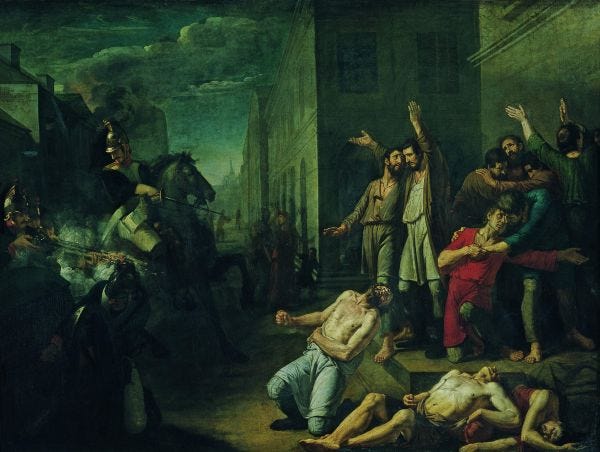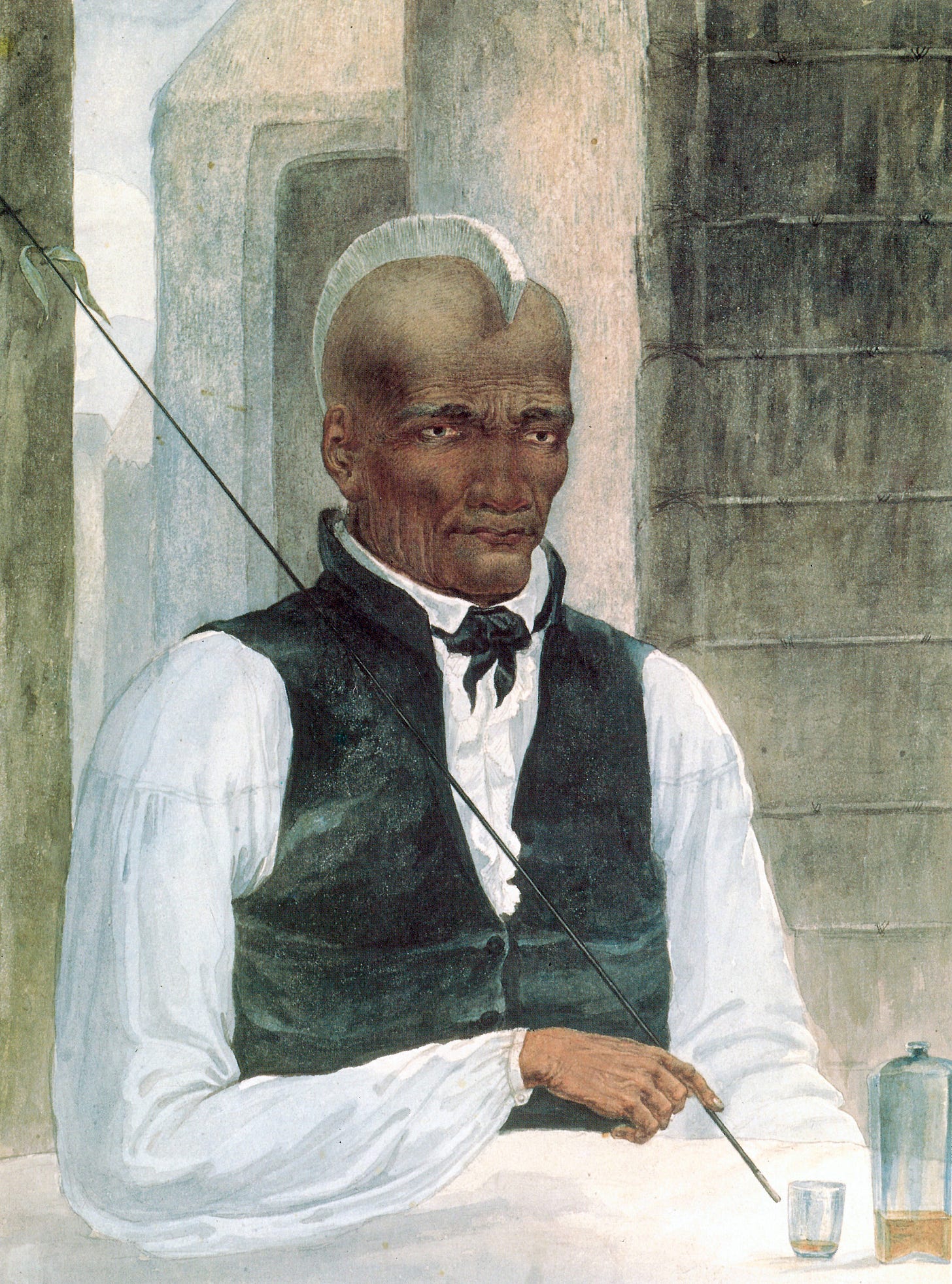

The great Russian artist Mikhail Tikhanov traveled along the Pacific Rim in 1817 and captured portraits of many men and women in the Pacific Northwest during that time. Thanks to his work, which is currently preserved in the Museum of the Russian Academy of Arts in Saint Petersburg, we are able today to gaze on the faces of many notable figures of history: King Kamehameha I, his successor Chief Boki, the famed Baron Alexandr Baranov, his enemy Chief Katlain, and numerous other named and unnamed characters are preserved thanks to the work and sacrifices of Mikhail Tikhanov.
Having toured the Northern Pacific, Tikhanov became seriously ill on his return voyage through the Philippines. As a result of this illness, which affected his mind, he spent the rest of his life on disability and drifting in and out of hospitals and sanitariums. After arriving in Russia, Tikhanov never produced another painting, and died in poverty with most of his work unpublished.
Despite having the support of the Russian government, prints of Mikhail Tikhanov's work where delayed, lost, and forgotten shortly after his return. It was not until 1971 that an incomplete collection of his work, featuring 22 prints, was first published in Russia. Several later books about Tikhanov have unearthed further works from him, and a collection of his water colours are on display at the Moscow Museum of Art. These haunting portraits of the Pacific Northwest are the earliest and in some cases the only depictions of life along the Pacific Northwest in the 1800s.
Of the numerous places he visited, some of the highest quality and most striking portraits were made during his visit to Hawaii. During this time he was able to produce the only known painting of King Kamehameha I, unifier of the Hawaiian Islands and founder of the Kingdom of Hawaii, during the last year of his life. He also captured Boki and his wife Liliha, who would go on to govern the kingdom immediately following the death of Kamehameha.
Young Girl of the Sandwich Islands, 1818
In this painting we see a girl cradling a small dog. Her features are striking, and there is a sharp use of shadows, but she has a very soft face. Its round and her cheeks and lips have a pleasant redness to them. Her eyes are unnaturally large, but it adds to the expressiveness of the portrait. Her hair is cut short on top, and left to grow long around the sides. There is lei of yellow plumeria. Around her head is a long red veil that she has wrapped around her naked body. Smiling, she is enveloped in a warm and shimmering rose coloured light.
The portrait invokes similarities with many Virgin Mary with Child portraits. The poise of the head, the tender smile and look, the young puppy sleeping tenderly in her arms, all recall the numerous tributes to maternal love that adorn the walls of any Catholic Church.. However the similarities only go so far. There is something deeply erotic about this painting. The strong contrast of shadows that plays out across her naked flesh invoke lamplight and darkness, not the sunny background of Hawaiian beaches. Her veil, which appears to be made of finely woven kapa, and glimmers in the sunlight, also appears to have been painted on as an afterthought. Thrown hastily over her naked body in a style that does not resemble any traditional Hawaiian fashion or appear anywhere else in Mikhail Tikhanov’s work
Indeed if you look closely you can see that the painting has undergone several changes in design during its creation. Her front arm goes to nowhere, and the dog appears to have been painted over the original work, probably masking Tikhanov’s constant inability to draw properly proportioned hands. Unlike his other Hawaiian works, this one does not seem to carry any political significance. The religious symbolism, however, is unmistakable.
Kamehameha, King of the Sandwich Islanders, 1818
The Legendary King Kamehameha unified the Hawaiian Islands in 1810, and founded the Kingdom of Hawaii. Mikhail Tikhanov met Kamehameha in the last year of his life, and painted his portrait. Despite Kamehameha's old age, his hair has already turned white, he has an intense and serious look to him, and his forehead is creased with wrinkles. King David Kalakaua, the last King of Hawaii, describes him as follows:
"Kamehameha was a man of tremendous physical and intellectual strength. In any land and in any age he would have been a leader. The impress of his mind remains with his crude and vigorous laws, and wherever he stepped is seen an imperishable track. He was so strong of limb that ordinary men were but children in his grasp, and in council the wisest yielded to his judgment. He seems to have been born a man and to have had no boyhood. He was always sedate and thoughtful, and from his earliest years cared for no sport or pastime that was not manly. He had a harsh and rugged face, less given to smiles than frowns, but strongly marked with lines indicative of self-reliance and changeless purpose. He was barbarous, unforgiving and merciless to his enemies, but just, sagacious and considerate in dealing with his subjects. He was more feared and admired than loved and respected; but his strength of arm and force of character well fitted him for the supreme chieftaincy of the group, and he accomplished what no one else could have done in his day."
It’s a testimony to Tikhanov’s skill that he was able to potray so accurately not only the appearance, but the unyielding of seriousness and purpose of Kamehameha’s soul. Dressed in European garb, his face covered in wrinkles, death only months away, Kamehameha still emanates a ferocious strength of will with every fiber of his being. No other man could have done what Kamehameha did in unifying the Hawaiian Islands and founding the Kamehameha dynasty. That Tikhanov could capture him so perfectly is irrefutable proof of his skill as an artist.
Boki, Chief of Oahu, and Hekili, Minister of the Navy, 1818
In the painting Boki, Chief of Oahu, and Hekili, Minister of the Navy. we get a close look at a male figures face. His hand is tucked under his robe in a similar manner to Kamehameha. From the title of the painting we can gather that this man is Boki, Chief of Oahu. In front of him, we see the side profile of another man, sporting a mustache, Hekili. Behind them, almost invisible, is a third character, a single hand carrying a spear.
Boki was a high chief and close right-hand man to Kamehameha, serving as Royal Governor of the island of Oahu and Minister of the Navy under Kamehameha I.
Boki and Liliha on the Kamchatka, 1818
In this painting four figures are present. Center a man with a bright coloured cape and somewhat somber expression stands holding a bottle and cup. Behind him, a woman sits atop a canon, she wears a yellow skirt and appears to be watching Tikhanov with suspicion. Around her neck is a dramatic looking necklace. Both man and woman appear to be drawn both in profile, and viewed from the back. This style is typical in Tikhanov's work, and many of his portraits feature multiple angles of the subject. Closer examination reveals that the man and the woman with their backs faced to the scene, although wearing identical clothes, are not the same man and woman as those drawn in profile. The man has short hair, and carries a spear. The woman is not wearing a necklace and crown. Behind her, a fifth man, barely visible, peaks out. He carries some kind of fan or standard. There is a striking similarity between the fanbearer of this portrait and the spear bearer of the other. Between the fan and the spear, the dual opulence and violence that underlie Hawaiian aristocratic society is constantly present, lingering in the background almost out of frame.
Boki and Liliha, a portrait by John Hayter 1818
These figures are, of course, Boki and his wife Liliha. Both Boki and his wife Kuini Liliha were leading members of a delegation to England led by King Kamehameha II and Queen Kamamalu in 1824. After the monarchs died from measles during the stay, Boki and his wife returned to Hawaii with Admiral Lord Byron aboard the British frigate, HMS Blonde, which bore the bodies of the late king and queen. They served as interm representatives of the Kingdom, and after returning from the voyage, opened a hotel and bar called the Blonde Hotel, the first of it’s kind on the Island Kingdom.
During their tour of England, they posed together for a second portrait by John Hayter. This allows for a rare opprotunity to compare their likeness to the portrait captured by Mikhail TIkhanov. As we can see, not only are there striking facial similarities, but Liliha is even wearing the same necklace in both paintings.
A full collection of Mikhail Tikhanov’s work can be found at www.tikhanovlibrary.com








